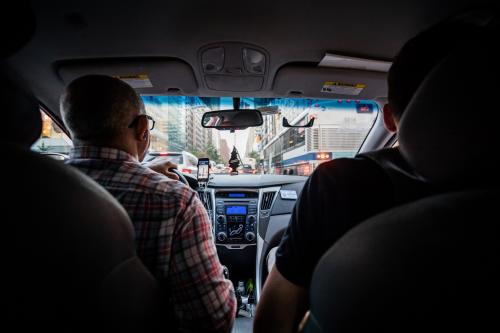Markets have battered Uber and Lyft stock since their respective IPOs, with Uber down over 5% and Lyft down over 20% since going public.
Part of that may well have to do with the (many) shaky aspects of their business model, which Uber’s own S-1 filing with the U.S. Securities and Exchange Commission details over nearly 50 pages. Contained within is specific mention of the firm’s “contractor” model.
Both companies rightly acknowledge that the contractor model, as well as potential regulatory changes to it, could be a concern for the longevity of their business.
All of which again raises the question of whether the contractor model—a core element of the gig economy in U.S. cities—is really such a viable way forward.
Without a doubt, the contractor model has created great value for both workers and consumers alike. For many drivers, it has created a flexible source of part-time work with relatively few barriers to entry. Likewise, it has provided many others a source of income at a time of slack labor demand during the recovery from the Great Recession.
But in recent years it has also become clear that the existing status quo is not sustainable, either for workers or the firms themselves.
In recent years it has become clear that the existing status quo is not sustainable, either for workers or the firms themselves.
For one thing, ridesharing drivers aren’t just independent contractors, as they generate the core source of revenue for Uber and Lyft. In that way, their drivers play a more fundamental role to the firm than, say, an external accountant that bills by the hour, or a contractor performing maintenance on a company’s building.
However, ridesharing drivers aren’t quite employees either. In particular, drivers have the flexibility to set their own schedules—they can drive whenever they want, for as many or as few hours as they desire.
More importantly for the workers, making a living as a driver has become difficult because of low and inconsistent pay, due in large part to the fact that companies do not need to pay contractors the minimum wage or overtime. And this trend may get worse for many drivers. Uber itself notes in its S-1 filing that “as we aim to reduce Driver incentives to improve our financial performance, we expect Driver dissatisfaction will generally increase.” And while the company says that it aims “to provide an earnings opportunity comparable to that available in retail, wholesale, or restaurant services,” those occupations entail a significant level of income volatility for many Americans.
To be sure, nobody is saying the companies’ stock is falling because of the contractor model, but we do wonder whether questions about it are contributing to a fog of uncertainty about the companies’ way forward. For example, Uber’s S-1 notes more than 60,000 drivers have filed, or plan to file, arbitration demands seeking damages due to independent contractor misclassification. It also notes that the company “may not be successful in defending the independent contractor status of Drivers in some or all jurisdictions,” such as with the California Supreme Court’s recent decision to establish a new standard for determining workers’ status as employees or independent contractors. Moving forward, investors will surely remain skittish given the patchwork of state regulations, and a national legal context that seems to change depending on which party controls the White House.
All of which raises the question of how the gig labor model might be adjusted in ways that can be more sustainable for both the firms and the workers.
New proposed labor models that work for both ridesharing drivers and firms
One idea proposed by our colleagues at the Hamilton Project describes creating a new category of “independent worker” between employee and independent contractor. These workers would have some rights enjoyed by employees, such as collective bargaining and employer contributions to payroll taxes. But crucially, they would be exempt from minimum wage protections, meaning these workers would miss out on one of the most important sources of economic security for low-income workers.
Another idea suggested by the Economic Policy Institute suggests that both existing technological capabilities and legal frameworks are sufficient to classify ridesharing drivers as employees. A third idea from the Information Technology and Innovation Foundation recommends a temporary exemption for internet platforms from many labor laws over the next five-to-10 years, ideally to be coupled with a comprehensive update of U.S. labor laws for the 21st century.
These are all interesting ideas, but we might suggest another possibility: combining a new worker classification with emerging models to enhance pay and benefits.
These are all interesting ideas, but we might suggest another possibility: combining a new worker classification with emerging models to enhance pay and benefits. For example, policymakers could pursue a modified version of New York’s pay rules for drivers, whereby ridesharing firms must pay workers enough to cover the metro area’s minimum wage, plus an extra margin for taxes and expenses. Such an effort could be coupled with a portable benefits platform that could help workers invest in worker’s compensation, paid leave, and retirement accounts.
Such a policy could have tradeoffs. Some financial risk from low driver utilization, i.e. when drivers have too few customers to make enough money, could shift onto the companies, because they would need to ensure drivers made at least minimum wage. This may result in ridesharing companies freezing or reducing the number of drivers they have, or pushing them toward maintaining a greater share of full-time drivers.
Likewise, such efforts may increase costs to consumers. For example, when New York implemented a minimum wage for drivers, ridesharing companies increased their prices (even though Uber’s marketing materials formerly suggested that the average Uber driver already made above the New York City minimum wage). But, to date, it hasn’t put Uber or Lyft out of business in New York—indeed both are still operating, as are other ridesharing services such as Via and Juno. Furthermore, a 2018 report suggested that ridesharing app companies could actually absorb an increase in driver pay with minimal fare increases.
Most importantly, this change would provide at least a tolerable living standard for the drivers who are actually providing the services.
In any event, a more sustainable solution than the current contractor model will almost certainly be necessary for drivers, investors, and the firms themselves moving forward. Yes, the platform-based gig economy has made many services more efficient and created a variety of innovations that we now take for granted in our lives. But now it’s time to make the system also work for the drivers who make it function on a daily basis.
The Brookings Institution is committed to quality, independence, and impact.
We are supported by a diverse array of funders. In line with our values and policies, each Brookings publication represents the sole views of its author(s).








Commentary
Uber’s IPO fallout underscores the need for a new labor model
May 23, 2019